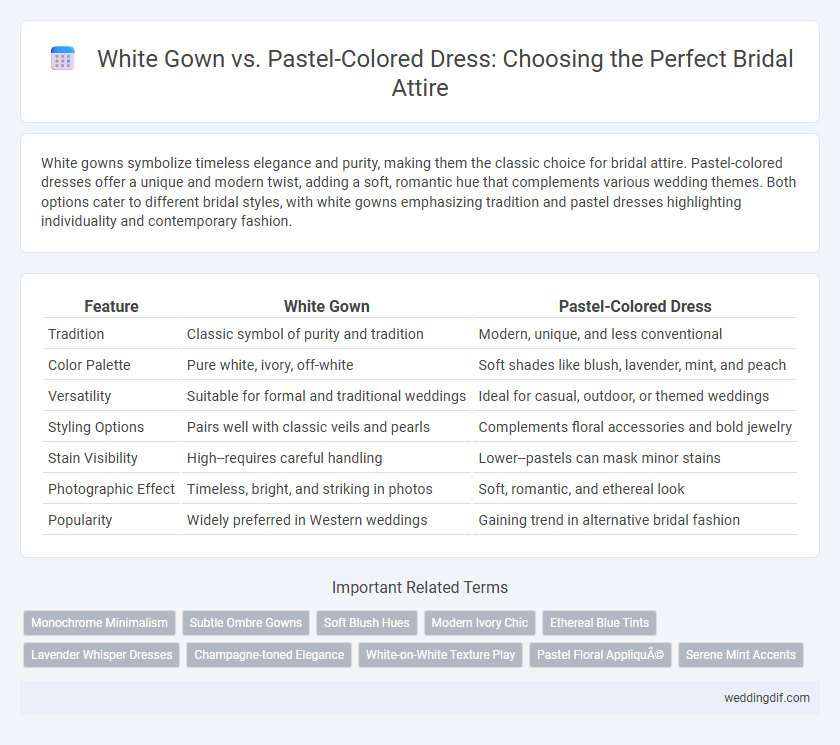White gowns symbolize timeless elegance and purity, making them the classic choice for bridal attire. Pastel-colored dresses offer a unique and modern twist, adding a soft, romantic hue that complements various wedding themes. Both options cater to different bridal styles, with white gowns emphasizing tradition and pastel dresses highlighting individuality and contemporary fashion.
Table of Comparison
| Feature | White Gown | Pastel-Colored Dress |
|---|---|---|
| Tradition | Classic symbol of purity and tradition | Modern, unique, and less conventional |
| Color Palette | Pure white, ivory, off-white | Soft shades like blush, lavender, mint, and peach |
| Versatility | Suitable for formal and traditional weddings | Ideal for casual, outdoor, or themed weddings |
| Styling Options | Pairs well with classic veils and pearls | Complements floral accessories and bold jewelry |
| Stain Visibility | High--requires careful handling | Lower--pastels can mask minor stains |
| Photographic Effect | Timeless, bright, and striking in photos | Soft, romantic, and ethereal look |
| Popularity | Widely preferred in Western weddings | Gaining trend in alternative bridal fashion |
Introduction: The Bridal Attire Dilemma
Choosing between a white gown and a pastel-colored dress presents a significant decision in bridal attire, reflecting diverse cultural traditions and personal style preferences. White gowns symbolize purity and timeless elegance, often associated with classic weddings, while pastel-colored dresses offer a modern, romantic alternative that embraces individuality and seasonal trends. The bridal attire dilemma revolves around balancing heritage with contemporary fashion to create a memorable wedding ensemble.
Historical Significance of the White Gown
The white gown, popularized by Queen Victoria in 1840, symbolizes purity and tradition in bridal attire, anchoring its historical significance deeply in Western wedding culture. Pastel-colored dresses, though increasingly embraced for their versatility and modern appeal, lack the longstanding cultural resonance that white gowns maintain. White gowns continue to dominate bridal fashion, representing a timeless homage to heritage and societal norms surrounding marriage ceremonies.
The Rise of Pastel-Colored Bridal Dresses
Pastel-colored bridal dresses have surged in popularity as modern brides seek alternatives to the traditional white gown, embracing soft hues like blush, lavender, and mint for a unique, romantic aesthetic. Designers are increasingly incorporating delicate pastel shades into their bridal collections, blending contemporary trends with timeless elegance to suit diverse wedding themes and personal styles. This shift reflects a broader movement towards customization and self-expression in bridal fashion, allowing brides to showcase individuality while maintaining a sophisticated look.
Seasonal Suitability of White vs Pastels
White gowns offer timeless elegance and reflect a crisp, bright feel suited for winter and spring weddings, enhancing the bride's radiant presence against natural seasonal backdrops. Pastel-colored dresses provide a softer, romantic vibe ideal for summer and autumn ceremonies, complementing the warm, vibrant tones of blooming flowers or falling leaves. Choosing between these hues depends on the desired seasonal harmony, with white emphasizing classic purity in colder months and pastels enriching the warmth and color of milder seasons.
Bridal Gown Symbolism: Purity vs Personality
The white bridal gown traditionally symbolizes purity, innocence, and new beginnings, deeply rooted in Western wedding customs. In contrast, pastel-colored dresses express individuality and personality, allowing brides to showcase their unique style while maintaining a soft, romantic aesthetic. Choosing between white and pastel hues reflects a balance between honoring classic symbolism and embracing contemporary bridal fashion trends.
Impact on Wedding Theme and Decor
White gowns create a classic and timeless aesthetic that complements traditional wedding themes and enhances elegant, neutral-toned decor. Pastel-colored dresses introduce subtle hues that can accentuate romantic or whimsical themes, harmonizing with floral arrangements and soft color palettes. Choosing between the two influences the overall ambiance, guiding the selection of decor elements to achieve either sophistication or a charming, personalized atmosphere.
Skin Tone Considerations for Color Choice
White gowns complement fair to medium skin tones by enhancing their natural radiance and creating a classic bridal look, while pastel-colored dresses, such as blush, lavender, or mint, flatter medium to darker skin tones by adding warmth and subtle contrast. Choosing bridal attire that harmonizes with skin undertones--cool undertones pairing well with icy whites and soft blues, warm undertones glowing in peach and coral pastels--ensures a balanced and flattering appearance. Tailoring gown colors to individual complexion not only highlights natural beauty but also elevates the overall bridal aesthetic.
Photography: White vs Pastel Dress Aesthetics
White gowns reflect natural light beautifully, creating crisp and timeless bridal portraits with high contrast and clarity. Pastel-colored dresses offer soft, romantic tones that blend seamlessly with nature or vintage settings, enhancing mood and depth in photography. Choosing between white and pastel attire significantly impacts the bridal photos' visual storytelling and overall aesthetic harmony.
Cultural and Regional Influences on Bridal Color
White gowns symbolize purity and tradition in Western weddings, deeply rooted in Victorian customs and popularized by Queen Victoria. Pastel-colored dresses often reflect cultural vibrancy and regional preferences, seen prominently in Indian and Southeast Asian bridal ceremonies where soft pinks, blues, and peaches hold symbolic significance. These color choices showcase how bridal attire varies globally, blending heritage and contemporary fashion trends.
Making the Final Choice: Tips for Brides
Choosing between a white gown and a pastel-colored dress for bridal attire depends on personal style, wedding theme, and cultural significance. Brides should consider the venue, season, and how each color complements their skin tone and accessories to ensure a cohesive look. Consulting with a stylist and trying on multiple options can help finalize a decision that reflects individuality and enhances bridal confidence.
White Gown vs Pastel-Colored Dress for Bridal Attire Infographic

 weddingdif.com
weddingdif.com